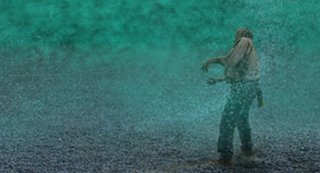 Vera (2003)
Vera (2003)Director: Francisco Athié
A few years ago, I attended the now-defunct Taos Talking Picture Festival where the Mexican film Vera was getting a rare showing. While the film did well in 2004 Ariel Awards in Mexico, it had not attracted a distributor and was doomed to a short run in a handful of festivals such as TTPF. Nonetheless, Vera was a surprise hit in Taos, perhaps due in part to the presence of the very personable Francisco Athié. His preface before the showing I attended was that we should treat Vera like an LSD trip. If you relax and go with it, he said, you will have a good trip. If not, you will have a bad trip.
Indeed, Vera is a strange, hallucinatory film that reveals itself in a slow, ritualistic way. An idyllic, rural scene gives way to a miner named Juan (Marco Antonio Arzate) lowering himself into a cave with his crude tools to go about his work. A cave-in appears to bury him. But no, he is swept through the cave in a torrent of water. An elec tric swarm, like a cloud of locusts, sweeps around him, pushing and bending him. A Mayan cauldron appears. He makes a deep cut in his penis and lets the blood run into the cauldron, from which a metal icon emerges. He makes his way through the cave until he reaches an egglike object that expands. A creature pushes its way through the birth canal of the object and emerges. It is young, blue, alien-like, with a visible and glowing heart. Eventually, it becomes larger and more substantial. The creature is Vera (Urara Kusanagi), and she appears to have been born to be Juan's guide through the cave. Vera and Juan encounter a skeleton. Vera dances with it gleefully. Juan flashes on images of his home, his grandchildren, and a couple making love.
tric swarm, like a cloud of locusts, sweeps around him, pushing and bending him. A Mayan cauldron appears. He makes a deep cut in his penis and lets the blood run into the cauldron, from which a metal icon emerges. He makes his way through the cave until he reaches an egglike object that expands. A creature pushes its way through the birth canal of the object and emerges. It is young, blue, alien-like, with a visible and glowing heart. Eventually, it becomes larger and more substantial. The creature is Vera (Urara Kusanagi), and she appears to have been born to be Juan's guide through the cave. Vera and Juan encounter a skeleton. Vera dances with it gleefully. Juan flashes on images of his home, his grandchildren, and a couple making love.
It should be clear by now that Juan is dying. Vera is his guide to the edge of death, a kind but singular creature that is both fearsome because it is unknown and a welcome presence in a dark and frightening place. Athié chose a Japanese butoh dancer to play Vera, and this is a high symbolic choice for the film. According to the Flesh & Blood Mystery Theater, butoh is "an enigma, an ever-evolving mystery. Violent or peaceful, slow or manic, painfully intimate or grandly spectacular, freely improvised or choreographed in stylized gestures, butoh seems to fly away from itself, resisting definition or explanation, yet profoundly transforming those who encounter it." When it comes to death, there are no national boundaries, no set rules--only the need to transform life to death and whatever comes after that.
Transformation occurs for the butoh dancer, too. We watch as Kusanagi grows thinner and thinner, the burden of her task in carrying the character of Juan across the river Styx (or some version of it) taking all her substance. Eventually, a Garden of Eden appears to Juan, as Vera holds the refreshment of fruits and light before him. We in the audience are returned to the rural idyll once again.
The story took hold in Athié's imagination as he was in the midst of and recovering from a life-threatening illness. It took him several years to make. He created the film's rudimentary computer graphics (newborn Vera and skeleton, for example) during classes he was taking to learn the art. Vera, I think, was an exorcism for him. He didn't seem to care about its commercial fate.
Vera holds a special place in my life. After I saw it, I was convinced that it was a perfect film for Facets, the nonprofit cinematheque and videotheque well-known throughout the United States and located in my town. I brought a tape of Vera to Charles Coleman, the programming director, and reminded him at least once a month that he really should look at it and consider the film for Facets. Eventually he did. Vera opened for one week at the very end of 2004--its only commercial run--and garnered a 3-star review in the Chicago Tribune from John Petrakis. I was a very proud film buff indeed.
Now I'm overjoyed to say that Facets will be releasing the DVD of Vera June 26 on its own publishing label. Francisco Athié has not made a film since Vera, though last I heard he was working on one. He has a small, but impressive output of films and certainly stands among the fine Mexican film makers who have emerged in recent years. I hope you will give the little film that could a viewing. It's got a lot of heart in it, especially mine. l
Vera will be shown July 14 and July 17, 2006, at the Gene Siskel Film Center in Chicago as part of its Mexican Tales of Darkness and Light series.


0 Comments:
Post a Comment
<< Home